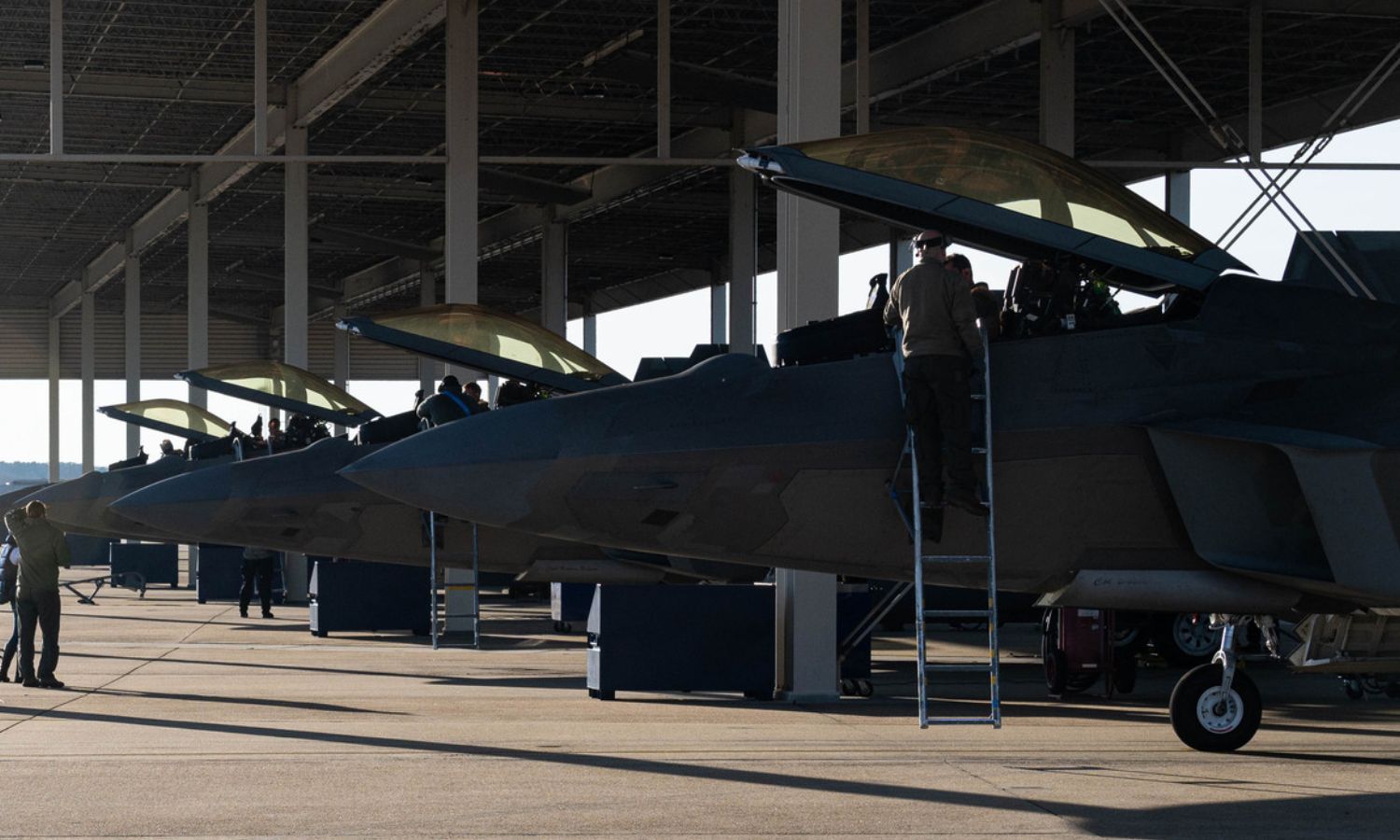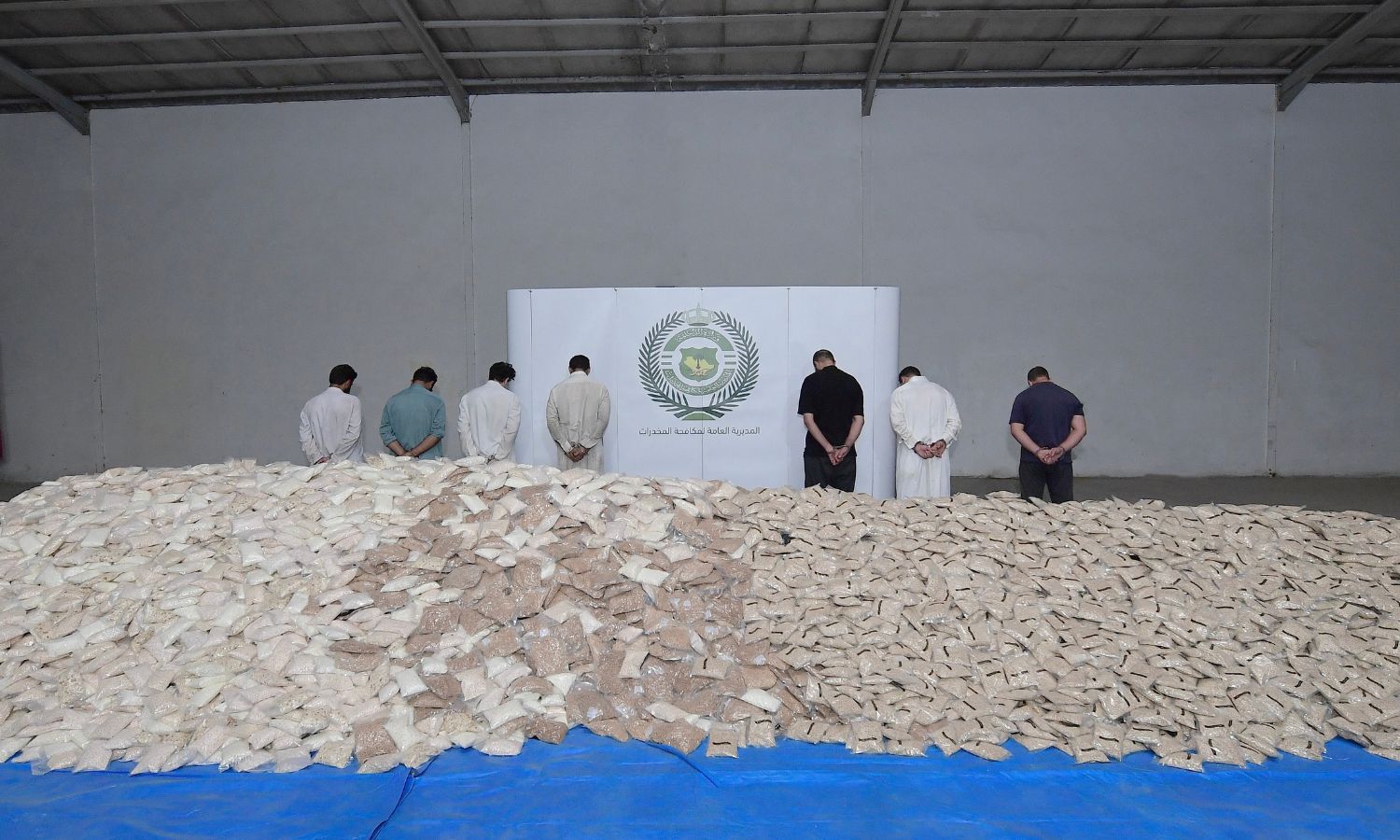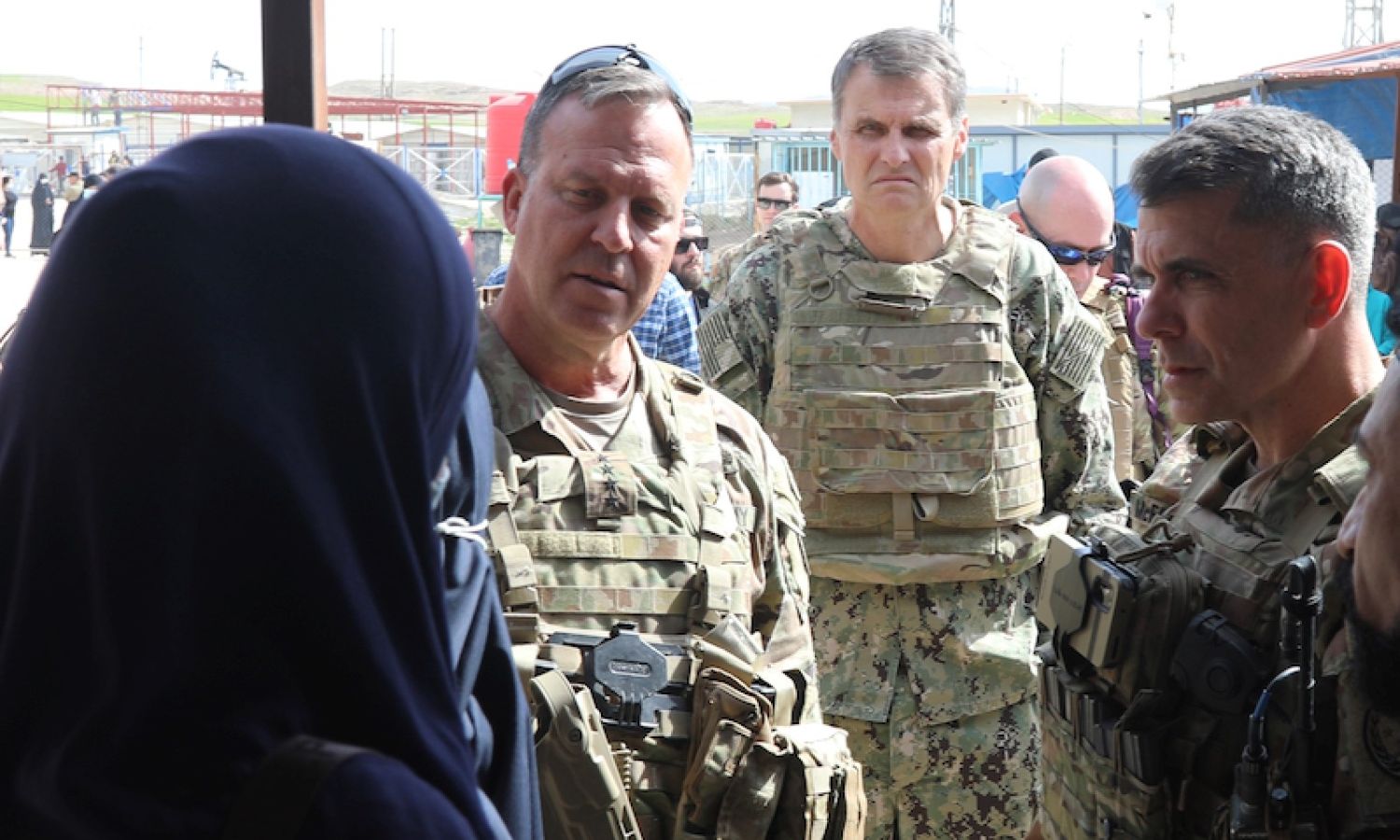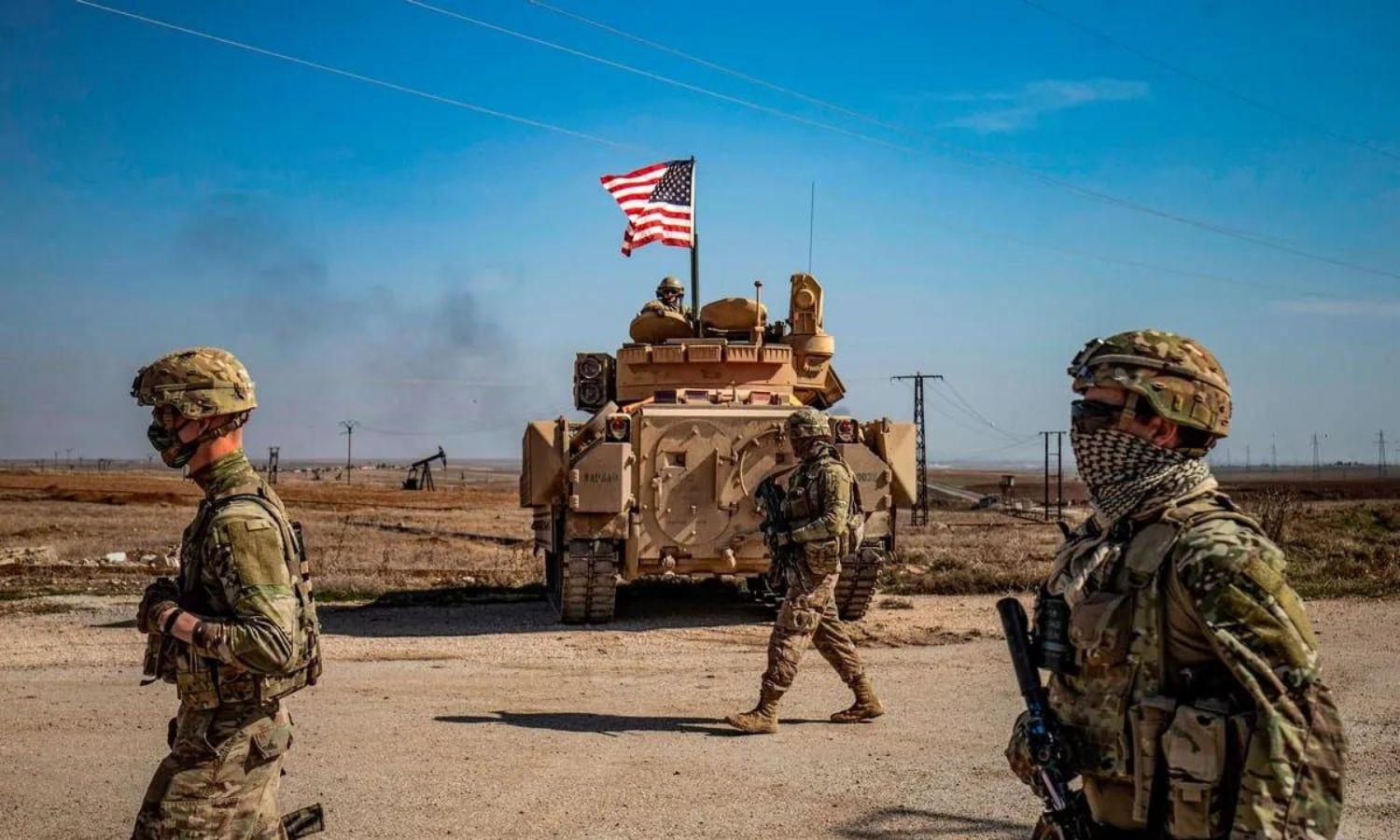



Enab Baladi – Khaled al-Jeratli
The US Central Command (CENTCOM) announced on June 14 the deployment of The 94th Fighter Squadron, which includes F-22 Raptor fighter jets, following the “increasingly unsafe and unprofessional behavior by Russian aircraft operating in Syria.”
The American air squadron is considered one of the oldest fighter squadrons in the history of America, according to what the United States announced about it through the official website of the Joint Base Langley-Eustis, Virginia.
Given the overlap of the US interests with those of other regional countries in Syria, researchers and specialists believe that there are many possible reasons behind these reinforcements, most notably the tension between Washington and Moscow due to violations of deconfliction protocols in Syria multiple times a day, putting the US forces at risk, according to US officials.
On December 23, 2022, US President Joe Biden signed the annual National Defense Authorization Act (NDAA), which included the “Countering Assad’s Proliferation Trafficking And Garnering Of Narcotics Act,” colloquially known as the Captagon Act.
The Act seeks to develop a coordinated strategy between the US Federal agencies to “deny, degrade and dismantle…narcotics production and trafficking networks” that are connected to the Syrian regime or otherwise linked to Bashar Al-Assad, according to the Syria Justice and Accountability Center (SJAC).
The Captagon Act states that the Syrian government’s trade in captagon is a “transnational security threat” to the US government.
Amer al-Sabaileh, geopolitical expert and non-resident fellow at the Stimson Center in Washington, told Enab Baladi that these reinforcements came at a time when Washington is intensifying “combat-terrorism” operations inside Syria, including operations to combat the Captagon drug trade.
Al-Sabaileh believes that the latest development may be followed by direct targeting of drug trade, smuggling, and manufacturing operations from Syria, especially since the 94th Fighter Squadron is capable of striking facilities, and therefore this development does not only fall under the cause of achieving American air supremacy in the region.
In general, the Jordanian professor considers that the presence of the F-22 Raptor fighter jet in the region guarantees a speedy response by the American forces and “procedural” operations for the forces deployed in Syria.
In answer to questions posed by Enab Baladi during a press conference, Lt. Gen. Alexus G. Grynkewich, the combined forces air component commander for US Central Command, said that the increase in the drug trade and its illegal flows from Syria is a matter of great concern.
He added that the United States certainly sees links between the Syrian regime and the network of drug smugglers from Syria to neighboring countries.
Grynkewich also considered that this trade would not be limited to the countries surrounding Syria only, as this danger could spread on a larger scale throughout the region and even beyond.
|
From the perspective of the United States, the fight against narcotics is not a military mission (…), but other agencies in the Washington government are working closely with neighboring countries to look for ways to enhance defensive measures and protocols to better secure their borders and stem the flow of drugs. US Air Force Lt. General Alexus Grynkewich, Combined Forces Air Component Commander for US Central Command, Southwest Asia |
In September 2022, an investigation published by the French Le Figaro revealed that about 250 million amphetamine pills had been seized around the world since the beginning of 2022 and were produced in Syria, which has become a drug smuggling country.
Georges Malbrunot, The author of the investigation, who covers Middle Eastern affairs, quoted a senior Jordanian official working in the drug and drug smuggling department in Jordan as saying that the Syrian regime began manufacturing Captagon in 2013 and was initially sending it to foreign jihadists in Syria.
| Amphetamine drugs stimulate the central nervous system, increasing alertness, boosting concentration and physical performance, and providing a feeling of well-being. |
But after that, the regime provided drug manufacturers and smugglers with advanced devices and tools, such as devices that facilitate smuggling operations such as night vision binoculars and drones to transport narcotic pills to Saudi Arabia via Jordan.
According to the official, the message of the head of the Syrian regime, Bashar al-Assad, behind sending shipments of Captagon to Jordan is clear and is evident in his “rehabilitation” as a condition for stopping shipments, as he put it.

Amphetamine pills seized by the Saudi authorities that were hidden inside a shipment of flour – August 31, 2022 (Twitter/General Directorate for Drug Control)
Years ago, demands were repeated within the corridors of American politics to withdraw military forces from Syria, and many projects were put forward in Congress for this purpose, the most prominent of which was in February, which ended in failure as the majority of the members of the Congress voted against it.
In addition to the draft resolutions that are presented from time to time in this regard, active regional countries in the Syrian file are trying to put pressure on Washington, including Russia, Turkey, and Iran, to push it towards the option of withdrawing from Syria and leaving the areas in northeastern Syria along with the Syrian Democratic Forces (SDF).
Rashid Hourani, military researcher at Jusoor Center for Studies, told Enab Baladi that the heavy reinforcements represented by the 94th Fighter Squadron relate to two aspects.
The first is internal, which reinforces the position of the current rejecting the withdrawal from Syria and stands in the face of members of Congress calling for the US to withdraw.
The other is external, aiming to stand in the way of the Russian-Iranian coordination against the US forces, which constitutes a threat to the presence of its forces in Syria and is gradually escalating.
The researcher added that the Russian-Iranian efforts are trying to eventually push the Americans out, but America has recently been working to form a deterrent force in the face of both sides in the face of any possible escalation against its forces in Syria.
Hourani believes that Washington’s ability to paralyze what it called the “aggressive operations” of Russian planes in its areas of influence in Syria is great, through electronic warfare and jamming these planes, in a way that impedes the implementation of its reconnaissance and information gathering missions.
The military expert considered that the US has the ability to actually attack Russian targets through its local allies (Free Syria Army and the SDF), especially since the active parties in Syria currently do not want to make any change to the status of the contact lines.
The US has about 900 soldiers in Syria, through which it aims to fight the Islamic State group by supporting the SDF, according to the statements of its officials. While US politicians argue that Congress has never authorized the participation of US forces in Syria but that it is “required by the US Constitution.”

US Central Command Commander Michael E. Corella visiting an IDP camp in northeastern Syria – March 11, 2023 (Twitter/Central Command)
While there are conflicting analyses about the new American deployment in the region, the researchers, al-Sabaileh and Hourani, believe that Washington is working to maintain its supremacy in the region at the expense of Russia.
Mustafa al-Nuaimi, expert in Iranian affairs, believes that the possibility that these reinforcements aim to clamp down on the smuggling of Iranian weapons is possible.
Al-Nuaimi told Enab Baladi that sending the 94th Fighter Squadron to the Middle East comes in the context of “deterrence messages” to Washington’s opponents operating in the Arab region in general and in Syria in particular.
However, this does not mean that these military capabilities will not be used to confront any attempt of aggression by pro-Iranian factions in the region, he adds.
The step of sending the squadron comes as a continuation of a previous project represented in sending two squadrons of interceptor bombers to the Middle East region, as one of them landed at al-Dhafra base in Abu Dhabi, and it includes an interceptor bomber specialized in confronting land armies, according to the researcher.
Al-Nuaimi considered that what is happening in the Middle East is a “clearly defined American project,” represented by sending “political and military messages to Iranian militias,” stating that they are now within the range of the US Air Force and its various types.
The researcher expects that the US will continue to enhance its air capabilities and support its allies in facing the potential dangers of Iran’s expansion in the Middle East in order to deter any attempt to attack US interests in Syria.
The researcher believes that today’s relative calm on Iran’s side in the region can be felt, as Tehran is trying to avoid taking a step that might provoke Washington or open a confrontation in which Iran will be the biggest loser.
In view of the next practical steps on the part of the United States, al-Nuaimi said that Washington is working to cut off the international arms smuggling route Tehran-Damascus-Beirut.
He added that the effectiveness of blocking this road cannot be fully achieved unless the US reaches its areas of influence east of the Euphrates with its garrison in al-Tanf.
This strategy may end up besieging Iran’s influence, which has extended to Syria during the past years, according to al-Nuaimi.

A patrol of American forces in the oil fields in Suwaidiyeh in al-Hasakah governorate, northeastern Syria – February 13, 2021 (AFP)
In a virtual briefing on June 21, Lieutenant General Alexus Grynkewich, the combined forces air component commander for US Central Command, accused the Russian air force of encouraging its pilots to engage in “buffoonery in the air,” raising the risk of accidents or even conflict in Syria.
The CENTCOM air forces commander also cautioned that Russia’s focus was on trying to provoke the US instead of maintaining its focus on counterterrorism, which is benefiting the Islamic State terror group.
“They are running training camps, and they’re building up their capabilities because the Russians in the regime are either incapable or unwilling to put pressure on ISIS,” he said, using an acronym for the group. “They’re letting the ISIS threat grow right under their nose,” according to VOA news network.
In a previous interview with Enab Baladi, Teresa L. Sullivan, a Public Affairs Officer in the United States Air Force Central (AFCENT), said that the US-led International Coalition forces and the Russian forces in Syria have well-established and agreed-upon protocols to prevent conflicts between the two sides’ operations.
These protocols outline procedures to reduce the risk of miscalculation or misunderstanding while operating in a combat zone and in proximity to each other.
AFCENT’s Public Affairs Officer told Enab Baladi that the US Air Force pilots continue to adhere to these agreed-upon protocols, but the Russian military recently departed from the standards expected of a professional Air Force, choosing instead to deliberately violate these agreements.
Russian aircraft have been operating in Syria for some time in an “unsafe and unprofessional” manner, according to Sullivan, who considered that Russia intends to carry out “aggressive maneuvers” and to commit non-deconflicted incursions into the areas of US army operations with increasing frequency.
On the other hand, Russia has repeatedly said officially that the US Air Force pilots “violate the deconfliction protocols in Syria,” according to Admiral Oleg Gorinov, deputy head of the Russian Center for Reconciliation in Syria.
Gorinov stated to Russia Today (RT) channel that American pilots activate the weapon systems when they approach Russian Air Force planes in Syria.
Sullivan, the National Security Strategic Communications Consultant, told Enab Baladi that when this type of Russian maneuver occurs in the area, the US Air Force uses radar and other on-board systems and sensors to avoid collision and maintain awareness of Russian aircraft flying nearby.
In a special online press briefing with Lieutenant General Alexus Grynkewich on June 21, the Combined Forces Air Component Commander for US Central Command expressed the importance of the F-22 as the most advanced air-superiority fighter in the world and their deployment in the region.
Grynkewich considered that it represents the ability of the United States to quickly transfer an important component of combat power, such as the “fifth generation air superiority” squadron, to the Middle East, which guarantees superiority for all of Washington’s regional partners.
While the United States does not have as many forces in the region on a permanent basis as it did years ago, it is still able to bring in another military force very quickly from outside the region.
Grynkewich added that F-22 Raptor fighter jets (fifth generation) were on another mission in Europe, and with the end of their mission, the US command deployed them in the Middle East for a “period of time,” as they would contribute to “regional stability” in the region.
The most prominent aim of the US reinforcements step is an attempt to reset the relationship with the Russians in Syria and “get them to return to adherence to protocols,” according to Grynkewich.
From a regional perspective, Grynkewich sees what matters in the latest US buildup is Washington’s ability to rapidly increase combat power.
|
Israel is clearly one of our close partners in the region – one of many but one that we’ve had a longstanding relationship with over the years and a long history with… So the first one of those is a commitment to mutual defense and defense of the Arabian Peninsula. So we work very closely with our partners, thinking about what are the triggers in the event of regional aggression where the United States would bring capabilities back in? US Air Force Lt. General Alexus Grynkewich, Combined Forces Air Component Commander for US Central Command, Southwest Asia |
For the first time, US forces entered Syria by air during the campaign of former US President Barack Obama’s administration against the Islamic State and al-Qaeda groups in 2014.
With the constant change in the number of US military personnel in Syria, the US Army has kept 900 soldiers there, as the latest announced official number, most of them in northeast Syria.
Iranian-backed militias, including the Lebanese Hezbollah and Iraqi groups loyal to Tehran, control sites in eastern, southern, and northern Syria and in the suburbs surrounding the capital, Damascus.
America has many military bases in northeastern Syria, the largest of which is known as the al-Omar oil field base in Deir Ezzor governorate, eastern Syria.
Russia is also spread out in many Syrian locations, and the Hmeimim airport in the countryside of Latakia city on the Mediterranean coast is Russia’s main headquarters in the region, and its other bases in the governorates of Aleppo, al-Hasakah, Deir Ezzor, and Tartous are managed from it.
On April 28, The Wall Street Journal quoted unnamed US officials as saying that the US military had put, for the first time, “bunker buster” bombs on attack aircraft recently sent to the Middle East in a message to Iran.
The decision to place more powerful weapons in a squadron of A-10 Warthogs was made to give pilots a greater chance of success in destroying munitions caches and other targets in Syria and Iraq after US forces were repeatedly targeted by Iranian-backed fighters, officials revealed to the WSJ.
if you think the article contain wrong information or you have additional details Send Correction